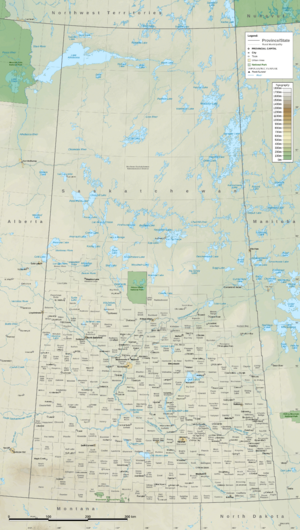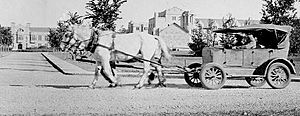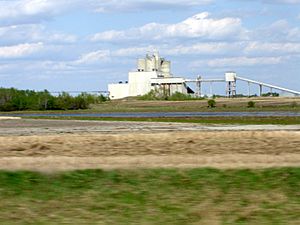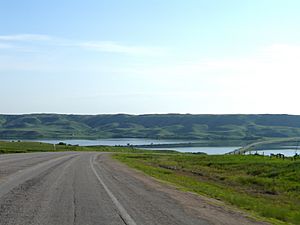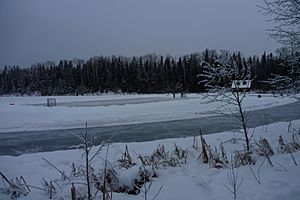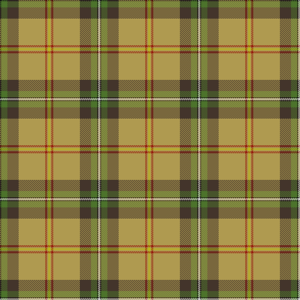Saskatchewan facts for kids
Quick facts for kids
Saskatchewan
|
|||
|---|---|---|---|
|
|||
| Motto(s): | |||
| Country | Canada | ||
| Confederation | September 1, 1905 (split from NWT) (10th, with Alberta) | ||
| Capital | Regina | ||
| Largest city | Saskatoon | ||
| Largest metro | Greater Saskatoon | ||
| Government | |||
| • Type | Parliamentary constitutional monarchy | ||
| Area | |||
| • Total | 651,900 km2 (251,700 sq mi) | ||
| • Land | 591,670 km2 (228,450 sq mi) | ||
| • Water | 59,366 km2 (22,921 sq mi) 9.1% | ||
| Area rank | Ranked 7th | ||
| 6.5% of Canada | |||
| Population
(2021)
|
|||
| • Total | 1,132,505 | ||
| • Estimate
(Q2 2024)
|
1,231,043 | ||
| • Rank | Ranked 6th | ||
| • Density | 1.91/km2 (4.9/sq mi) | ||
| Demonym(s) | Saskatchewanian (official) | ||
| Official languages | English | ||
| GDP | |||
| • Rank | 5th | ||
| • Total (2015) | CA$79.415 billion | ||
| • Per capita | CA$70,138 (4th) | ||
| HDI | |||
| • HDI (2019) | 0.921 — Very high (8th) | ||
| Time zones | |||
| year-round in most areas | UTC−06:00 (Central) | ||
| Lloydminster and nearby areas | UTC−07:00 (Mountain) | ||
| • Summer (DST) | UTC−06:00 (Mountain DST) | ||
| Postal abbr. |
SK
|
||
| Postal code prefix |
S
|
||
| ISO 3166 code | CA-SK | ||
| Flower | Western red lily | ||
| Tree | Paper birch | ||
| Bird | Sharp-tailed grouse | ||
| Rankings include all provinces and territories | |||
Saskatchewan (pronounced sə-SKATCH-ə-wən) is a province in Western Canada. It is bordered by Alberta to the west, the Northwest Territories to the north, and Manitoba to the east. To the south, it shares a border with the U.S. states of Montana and North Dakota. Saskatchewan and Alberta are the only Canadian provinces that do not touch an ocean.
In 2024, about 1.2 million people lived in Saskatchewan. A large part of the province, nearly 10%, is covered by fresh water, including many rivers and lakes. Most people live in the southern part of the province, which is mostly flat prairie land. The northern part is covered in forests and has fewer people.
About half of Saskatchewan's residents live in its two largest cities: Saskatoon and the capital city, Regina. Other important cities include Prince Albert, Moose Jaw, and Swift Current. English is the main language spoken by most people in Saskatchewan.
Indigenous peoples have lived in Saskatchewan for thousands of years. Europeans first explored the area in 1690 and settled there in 1774. Saskatchewan became a province in 1905. Its economy is mainly based on agriculture, mining, and energy.
Today, Saskatchewan is led by Premier Scott Moe and the Saskatchewan Party. In 1992, the governments signed an important agreement with First Nations in Saskatchewan about land claims. This allowed First Nations to buy land to create new reserve areas.
Contents
What's in a Name?
The name Saskatchewan comes from the Saskatchewan River. In the Cree language, the river was called kisiskāciwani-sīpiy, which means "swift flowing river."
Saskatchewan's Landscape
Saskatchewan's borders mostly follow straight lines of longitude and latitude, making it look like a four-sided shape. It is part of the Western Provinces of Canada. Saskatchewan is unique because its borders do not follow natural features like rivers or mountains. Along with Alberta, it is one of only two provinces that are landlocked, meaning they are completely surrounded by land.
Most of Saskatchewan's population lives in the southern third of the province. This area is south of the 53rd parallel.
Saskatchewan has two main natural areas: the Canadian Shield in the north and the Interior Plains in the south. Northern Saskatchewan is mostly covered by boreal forests. It also has the Lake Athabasca Sand Dunes, which are the largest active sand dunes north of 58 degrees latitude. In the south, there are also sand dunes called the "Great Sand Hills." The Cypress Hills in the southwest were not covered by ice during the last ice age.
The highest point in the province is in the Cypress Hills, reaching 1,392 meters (4,567 feet). The lowest point is the shore of Lake Athabasca, at 213 meters (699 feet). Many rivers and watersheds in Saskatchewan drain into the Arctic Ocean, Hudson Bay, and the Gulf of Mexico.
Saskatchewan's Weather
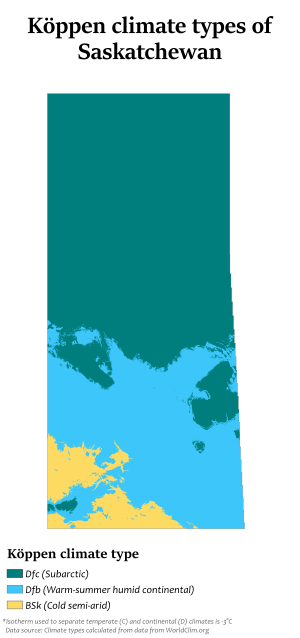
Saskatchewan gets more hours of sunshine than any other Canadian province. Because it's far from large bodies of water, it has warm summers. Most of the province has a humid continental climate. The southwest has a drier, semi-arid climate. Sometimes, long periods without rain can cause droughts, which affect farms.
Northern Saskatchewan has a subarctic climate with shorter summers. Summers can be very hot, sometimes reaching over 38°C (100°F). Warm winds from the south often blow in July and August. Winters are usually very cold, with temperatures staying below -17°C (1°F) for weeks. However, warm chinook winds from the west can bring milder weather.
On average, Saskatchewan gets 30 to 45 centimeters (12 to 18 inches) of rain each year. Most of this rain falls in June, July, and August.
Saskatchewan is one of the most active places for tornadoes in Canada. It averages about 12 to 18 tornadoes each year. Some of these can be very strong. In June 1912, the Regina Cyclone hit, killing 28 people. Severe thunderstorms with hail, strong winds, and tornadoes are common from spring to late summer.
The hottest temperature ever recorded in Canada was in Saskatchewan. It reached 45°C (113°F) in Midale and Yellow Grass. The coldest temperature recorded in the province was -56.7°C (-70°F) in Prince Albert.
| City | July (°C) | July (°F) | January (°C) | January (°F) |
|---|---|---|---|---|
| Maple Creek | 27/11 | 81/52 | -5/-16 | 23/4 |
| Estevan | 27/13 | 81/55 | -9/-20 | 16/-4 |
| Weyburn | 26/12 | 79/54 | -10/-21 | 14/-6 |
| Moose Jaw | 26/12 | 79/54 | -8/-19 | 18/-2 |
| Regina | 26/11 | 79/52 | -10/-22 | 14/-8 |
| Saskatoon | 25/11 | 77/52 | -12/-22 | 10/-8 |
| Melville | 25/11 | 77/52 | -12/-23 | 10/-9 |
| Swift Current | 25/11 | 77/52 | -7/-17 | 19/1 |
| Humboldt | 24/11 | 75/52 | -12/-23 | 10/-9 |
| Melfort | 24/11 | 75/52 | -14/-23 | 7/-9 |
| North Battleford | 24/11 | 75/52 | -12/-22 | 10/-8 |
| Yorkton | 24/11 | 75/52 | -13/-23 | 9/-9 |
| Lloydminster | 23/11 | 73/52 | -10/-19 | 14/-2 |
| Prince Albert | 23.9/11.1 | 75/52 | -13/-25.2 | 9/-13 |
Saskatchewan's Past

Saskatchewan has been home to many different Indigenous peoples for a long time. These include the Cree, Saulteaux, Assiniboine, and Lakota. The first European known to visit Saskatchewan was Henry Kelsey in 1690. He traveled up the Saskatchewan River to trade furs with Indigenous groups. The first lasting European settlement was at Cumberland House, founded in 1774.
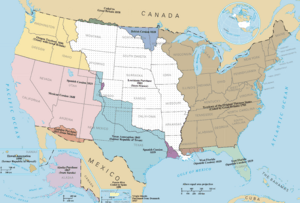
Most of what is now Saskatchewan was part of Rupert's Land. This area was controlled by the Hudson's Bay Company, which claimed land where rivers flowed into Hudson Bay. In 1870, Canada took over these territories and created the Northwest Territories. The government also signed agreements called Numbered Treaties with Indigenous peoples. These treaties set up the relationship between First Nations and the government.

In 1885, a conflict known as the North-West Rebellion took place in Saskatchewan. The Métis people, led by Louis Riel, fought against the Canadian government over land issues. The Métis were defeated, and Riel was executed. Since then, the government has recognized the Métis as an Indigenous people with special rights.
European settlers began to arrive in large numbers after the Canadian Pacific Railway was built in the early 1880s. The Canadian government offered free land to settlers. Many new settlers came, creating a farming society.
The 20th Century
As more settlers arrived, Saskatchewan's population grew quickly. On September 1, 1905, Saskatchewan officially became a province. The Dominion Lands Act allowed settlers to claim land for farming. Immigration was highest around 1910. Despite challenges, new settlers built successful farms.
In 1913, the Saskatchewan Stock Growers Association was formed to support ranchers. Its goals were to look after laws, help ranchers, and suggest new laws.
In 1970, the first Canadian Western Agribition was held in Regina. This big farm trade show, especially known for its livestock, is one of the top five livestock shows in North America.
In 1980, Saskatchewan celebrated its 75th birthday. In 2005, for its 100th birthday, Queen Elizabeth II visited the province. Since the late 1900s, First Nations have worked to get justice for past land losses. The governments have negotiated many land claims, helping First Nations buy land for reserves.
Who Lives in Saskatchewan?
- Saskatchewan census statistics
Languages of Saskatchewan (2016): English (82.4%) French (1.4%) Other language (14.5%) Multiple (1.7%)
Indigenous and visible minority identity (2021): European Canadian (68.5%) Visible minority (14.4%) First Nations (11.0%) Métis (5.7%) Other Indigenous (0.3%)
Ethnic Backgrounds
According to the 2011 Canadian census, the largest ethnic group in Saskatchewan is German (28.6%). Other large groups include English (24.9%), Scottish (18.9%), Canadian (18.8%), Irish (15.5%), Ukrainian (13.5%), French (12.2%), and First Nations (12.1%).
Languages Spoken
As of the 2021 Canadian census, the most spoken languages in Saskatchewan are English (99.24%), French (4.72%), and Tagalog (3.27%). Other languages spoken include Cree, Hindi, Punjabi, and German.
Religions
According to the 2021 census, most people in Saskatchewan identify as Christian (56.3%). A significant number of people (36.6%) report having no religion. Other religions practiced include Islam, Indigenous Spirituality, Hinduism, and Sikhism.
Saskatchewan's Economy
Historically, Saskatchewan's economy was mostly about agriculture, especially growing wheat. Today, the economy is more diverse. Agriculture, forestry, fishing, and hunting made up 8.9% of the province's economy in 2018. Saskatchewan grows a large amount of Canada's grain. In 2017, the province produced more canola than wheat. Farmers' total income from farming was $3.3 billion in 2017. Other crops grown include flax, rye, oats, peas, lentils, and barley. Saskatchewan is the world's largest exporter of mustard seed. The province also raises a lot of beef cattle. In northern Saskatchewan, forestry is an important industry.
| What Makes Up Saskatchewan's Economy (2018) | |
|---|---|
| % Share of GDP | Sector |
| 8.9 | Farming, forests, fishing, hunting |
| 14.2 | Money, insurance, real estate, leasing |
| 2.5 | Professional and food services |
| 8.14 | Building and construction |
| 11.51 | Education, health, social services |
| 1.74 | Hotels and restaurants |
| 1.46 | Information and culture |
| 5.96 | Government services |
| 6.43 | Manufacturing (making things) |
| 17.05 | Mining, oil, and gas |
| 3.87 | Other industries |
| 8.05 | Transportation, communication, utilities |
| 10.19 | Buying and selling goods |
Mining is a very important industry. Saskatchewan is the world's largest exporter of potash (used in fertilizer) and uranium (used for nuclear energy). Oil and natural gas production are also big parts of the economy. Only Alberta produces more oil than Saskatchewan among Canadian provinces.
Some major companies based in Saskatchewan include Nutrien (a large fertilizer company) and Federated Cooperatives Ltd.. The province also has several Crown corporations, which are businesses owned by the government. These include Saskatchewan Government Insurance (SGI), SaskTel (phone and internet), SaskEnergy (natural gas), and SaskPower (electricity).
Learning in Saskatchewan
Public schools in Saskatchewan are managed by 27 different school divisions. Most schools teach in English. There is one school division that offers French-first language schools. Besides elementary and high schools, Saskatchewan also has several colleges and universities.
The first schools in the prairies were for First Nations families and early fur traders. Later, more formal schools were set up. In 1886, the first school districts and Board of Education meeting were formed. As more people settled, communities wanted schools similar to those in their home countries. Log cabins often served as places for school, church, and community gatherings.
In the 1920s, as farmers became more successful, there was more money for education. Schools became more standardized with textbooks, teacher training, and official lesson plans. English became the common language in schools, which helped people communicate and trade. By the late 1940s, there were about 5,000 one-room schoolhouses in Saskatchewan.
After World War II, many one-room schools closed. Students started going to larger, more modern schools in towns and cities. School buses and better roads made it easier for students to travel. This change also happened as farms became larger and needed fewer people to work them.
Health Care in Saskatchewan
Saskatchewan's Ministry of Health is in charge of health care. It sets rules, checks standards, and provides money for health services. Saskatchewan has a single-payer health care system. This means the government pays for most medical services. Doctors are independent, but they send their bills to the government's Saskatchewan Medical Care Insurance Plan. Patients do not pay doctors or hospitals directly for medical care.
In 1944, the Co-operative Commonwealth Federation (CCF) party won the provincial election. They formed the first socialist government in North America. In the early 1960s, the CCF promised universal health coverage (health care for everyone). After winning another election, they put this plan into action. This was the first time in Canada that everyone had health care coverage.
However, doctors in the province strongly opposed this new system and went on a big strike. The strike ended after a few weeks, and universal health coverage was adopted. Five years later, this type of health care was adopted across all of Canada.
Getting Around Saskatchewan
Saskatchewan has a large system of roads, highways, airports, and railways. The province has over 250,000 kilometers (155,000 miles) of roads and highways. This is the most road surface of any Canadian province. About 80% of traffic uses the main highway system, which is about 5,031 kilometers (3,126 miles) long.
The Ministry of Highways and Infrastructure manages over 26,000 kilometers (16,000 miles) of highways. In the northern part of the province, there are also about 150 kilometers (93 miles) of ice roads that can only be used in winter.
Major highways include the Trans Canada expressway and the Yellowhead Highway. The first Canadian transcontinental railway was built between 1881 and 1885. Today, only two passenger train services operate in Saskatchewan: The Canadian and the Winnipeg–Churchill train, both run by Via Rail.
Saskatchewan has 3,050 bridges and 12 ferry services. The main airports are Saskatoon Airport and Regina International Airport. Both airports were important for training pilots during World War II.
The Canadian government has invested money to improve transportation in Saskatoon and Regina. This includes building new interchanges and improving access to freight terminals. These projects help increase trade with Asia-Pacific countries.
Saskatchewan's Culture
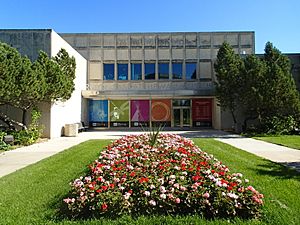
Saskatchewan has many museums. The Royal Saskatchewan Museum is the province's main museum. Other museums include Diefenbaker House, the Evolution of Education Museum, and the Saskatchewan Science Centre. The Saskatchewan Western Development Museum shows the history of the province.
Art in Saskatchewan
The province has several art galleries, such as the MacKenzie Art Gallery and Remai Modern. There are also places for performing arts, like the Conexus Arts Centre in Regina and TCU Place in Saskatoon.
Music in Saskatchewan
Saskatchewan is home to several concert orchestras. These include the Regina Symphony Orchestra, the Saskatoon Symphony Orchestra, and the Saskatoon Youth Orchestra.
Literature in Saskatchewan
A famous writer from Saskatchewan was W. O. Mitchell (1914–1998), who was born in Weyburn. His most popular novel is Who Has Seen the Wind (1947). This book describes life on the Canadian Prairies and sold almost a million copies in Canada. He was also known for his radio show, Jake and the Kid, which was also about life on the Prairies.
Sports in Saskatchewan
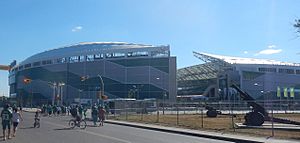
Hockey is the most popular sport in Saskatchewan. More than 500 National Hockey League (NHL) players were born in Saskatchewan. This is the highest number per person of any Canadian province or country. Famous players include Gordie Howe, who is considered one of the greatest hockey players ever. Other notable NHL players from Saskatchewan include Bryan Trottier, Bernie Federko, and Patrick Marleau.
Many important women's hockey players also come from Saskatchewan, like Hayley Wickenheiser and Colleen Sostorics. Hayley Wickenheiser was the first female skater to play professional hockey in a men's league. Saskatchewan does not have an NHL team, but it has five junior hockey teams in the Western Hockey League. These include the Moose Jaw Warriors and the Saskatoon Blades.
The Saskatchewan Roughriders are the province's professional Canadian football team. They play in the Canadian Football League and are based in Regina. Their fans are known as "Rider Nation." The Roughriders are one of the oldest professional sports teams in North America. They have won four Grey Cup championships. The province also has successful women's football teams, the Saskatoon Valkyries and the Regina Riot.
Saskatchewan has two other professional sports teams. The Saskatchewan Rush play in the National Lacrosse League. In 2016, they won their division and the league championship. The Saskatchewan Rattlers play in the Canadian Elite Basketball League and won the league's first championship in 2019.
Curling is the official sport of the province. Saskatchewan has a strong history in curling. Teams from Saskatchewan have won many national and world championships. Famous curlers from Saskatchewan include Sandra Schmirler, whose team won a gold medal at the 1998 Olympics.
| Team | City | League | Since | Stadium/Arena | Capacity |
|---|---|---|---|---|---|
| Saskatchewan Roughriders | Regina | Canadian Football League | 1910 | Mosaic Stadium | 33,350 |
| Saskatchewan Rush | Saskatoon | National Lacrosse League | 2016 | SaskTel Centre | 15,100 |
| Saskatchewan Rattlers | Saskatoon | Canadian Elite Basketball League | 2019 | SaskTel Centre | 15,100 |
| Regina Pats | Regina | Canadian Hockey League | 1917 | Brandt Centre | 6,000 |
| Saskatoon Blades | Saskatoon | Canadian Hockey League | 1966 | SaskTel Centre | 15,100 |
| Swift Current Broncos | Swift Current | Canadian Hockey League | 1967 | Innovation Credit Union iPlex | 2,879 |
| Prince Albert Raiders | Prince Albert | Canadian Hockey League | 1982 | Art Hauser Centre | 2,580 |
| Moose Jaw Warriors | Moose Jaw | Canadian Hockey League | 1984 | Mosaic Place | 4,414 |
| Saskatoon Valkyries | Saskatoon | Western Women's Canadian Football League | 2010 | Saskatoon Minor Football Field | 5,000 |
| Regina Riot | Regina | Western Women's Canadian Football League | 2010 | Leibel Field | 1,200 |
Saskatchewan's Symbols
The flag of Saskatchewan was chosen on September 22, 1969. It has the provincial shield near the flagpole. The floral emblem, the Prairie Lily, is on the other side. The green top half of the flag shows the northern forests. The golden bottom half represents the southern wheat fields and prairies. A contest was held to design the flag, and over 4,000 ideas were submitted. Anthony Drake's design was chosen.
In 2005, Saskatchewan Environment held a vote to choose a provincial fish for the province's 100th birthday. The walleye was the clear winner, getting more than half of the votes.
Other symbols of Saskatchewan include its tartan, licence plate, and provincial flower. The official tartan was registered in Scotland in 1961. It has seven colors: gold, brown, green, red, yellow, white, and black. The provincial licence plates say "Land of Living Skies." The provincial flower of Saskatchewan is the western red lily.
Centennial Celebrations
In 2005, Saskatchewan celebrated its 100th birthday. To mark this special year, the Royal Canadian Mint made a special five-dollar coin and a 25-cent coin. Queen Elizabeth II and Prince Philip visited Regina, Saskatoon, and Lumsden. The famous singer Joni Mitchell, who grew up in Saskatchewan, released an album to honor the province.
See also
 In Spanish: Saskatchewan para niños
In Spanish: Saskatchewan para niños





